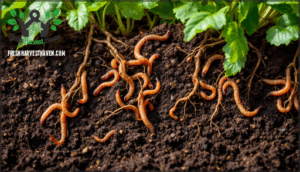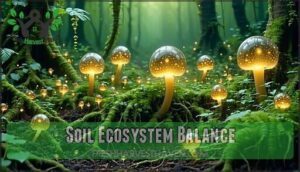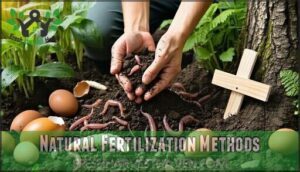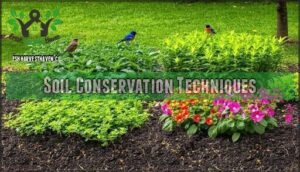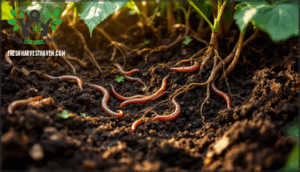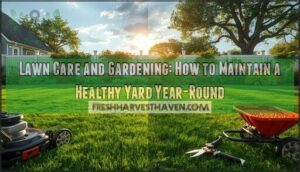This site is supported by our readers. We may earn a commission, at no cost to you, if you purchase through links.
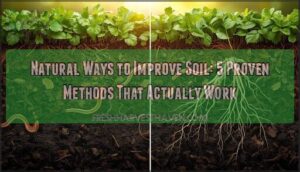
Create your own compost from kitchen scraps and yard waste, then apply mulch like straw or wood chips to retain moisture.
Encourage beneficial microorganisms and mycorrhizal fungi that cycle nutrients and support plant health.
Plant nitrogen-fixing cover crops like clover between growing seasons, and use crop rotation to break pest cycles.
Minimize tilling to preserve soil structure and beneficial organisms.
These methods work together to create a thriving underground ecosystem that feeds your plants while building long-term soil health through nature’s own proven processes.
Table Of Contents
- Key Takeaways
- Improving Soil Structure
- Soil Ecosystem Balance
- Natural Fertilization Methods
- Soil Conservation Techniques
- Maintaining Soil Health
- Frequently Asked Questions (FAQs)
- What improves soil naturally?
- How to make healthy soil naturally?
- How to bring soil back to life naturally?
- How to fix poor quality soil?
- How can I enrich poor soil naturally?
- How do you rebuild soil organically?
- What can I add to soil to make it healthy?
- How do you rejuvenate old soil?
- How long does soil improvement take to show results?
- Can I improve soil during winter months effectively?
- Conclusion
Key Takeaways
- You’ll transform your soil by adding organic matter like compost, worm castings, and leaf mold—these naturally improve drainage while feeding beneficial microorganisms that create thriving underground ecosystems.
- You can eliminate synthetic fertilizers by planting nitrogen-fixing cover crops like clover and legumes, which work with soil bacteria to capture atmospheric nitrogen and enrich your garden naturally.
- You’ll protect your soil’s living structure by minimizing tilling and avoiding heavy foot traffic—this preserves earthworm tunnels and fungal networks that are essential for nutrient cycling and plant health.
- You’ll see dramatic long-term results by combining mulching, crop rotation, and beneficial microorganisms—these methods work together to create self-sustaining soil that gets healthier each season without expensive chemicals.
Improving Soil Structure
You’ll notice dramatic improvements in your garden when you focus on building healthy soil structure through natural methods.
The secret lies in working with nature’s systems rather than against them, creating loose, well-draining soil that plants absolutely love.
Adding Organic Matter
You’ll transform your garden’s foundation by adding organic matter—nature’s ultimate soil conditioner that turns stubborn clay into workable earth and helps sandy soil retain moisture like a thirsty sponge drinks water.
Transform stubborn clay into garden gold—organic matter turns any soil into a plant paradise!
Compost benefits shine when you incorporate these proven natural fertilizers into your soil improvement routine:
- Leaf mold from decomposed autumn leaves creates perfect soil structure
- Manure application delivers slow-release nutrients and beneficial microorganisms
- Worm castings provide gentle fertilization while boosting soil health
- Kitchen scraps and yard waste create organic compost that feeds soil organisms
These mulch types work best when applied to the surface, allowing earthworms to naturally incorporate them into your soil’s living ecosystem.
These methods also help with balancing carbon and nitrogen in the soil.
Using Compost and Mulch
Your kitchen scraps become garden gold through proper composting techniques.
Compost benefits include enhanced soil organic matter and improved water retention. Decomposition rates vary by system—tumblers work faster than traditional bins.
For faster results, consider using efficient compost systems.
Sourcing materials from grass clippings, leaves, and food waste creates nutrient-rich organic compost.
Mulch types like straw or wood chips protect soil surface. Application techniques involve spreading a two-inch organic mulch layer around plants, boosting soil health through natural soil improvement processes.
Minimizing Mechanical Disturbance
After enriching your soil with compost and mulch, resist the urge to till or dig excessively.
No-till benefits include preserving soil structure and protecting worm pathways that naturally aerate your garden.
When you avoid mechanical disturbance, soil organisms thrive, creating biological channels for water and roots.
This notill farming approach reduces soil compaction reduction while maintaining healthy soil ecosystems through natural aeration alternatives.
Soil Ecosystem Balance
Your soil isn’t just dirt—it’s a thriving underground city packed with billions of microorganisms working around the clock to feed your plants.
Think of your soil as nature’s bustling metropolis—billions of microscopic workers creating plant paradise beneath your feet
When you understand how these tiny workers collaborate with fungi and cycle nutrients, you’ll discover the secret to naturally fertile soil that practically grows itself.
Role of Microorganisms
Your soil’s underground workforce operates 24/7, creating the foundation for thriving plants.
These soil microorganisms form complex networks that transform nutrients, protect roots, and maintain garden health through intricate biological processes.
- Microbe Benefits include nutrient cycling – Beneficial microbes break down organic matter into plant-available forms
- Bacterial Roles support root health – Soil biota create protective barriers against pathogens while enhancing nutrient uptake
- Microbial Balance drives ecosystem stability – Diverse soil biology maintains natural pest control and ideal growing conditions
Importance of Mycorrhizal Fungi
Discover how fungal networks create underground highways that connect your plants.
These mycorrhizae fungi boost nutrient uptake by 40% while strengthening plant immunity through soil symbiosis.
Their ecosystem services transform ordinary dirt into thriving soil biology.
| Mycorrhizal Benefits | Impact | Result |
|---|---|---|
| Nutrient Exchange | 40% better phosphorus uptake | Stronger plant growth |
| Fungi Diversity | Enhanced soil microbiology | Disease resistance |
| Beneficial Microbes | Improved soil fertility management | Reduced fertilizer needs |
Nutrient Cycling and Energy Flows
Underground, billions of soil microorganisms work like nature’s recycling crew, breaking down organic matter into nutrients your plants can actually use.
This microbial activity drives nutrient cycling, where decomposers release nitrogen, phosphorus, and potassium while facilitating energy transfer between roots and fungi.
Soil respiration occurs as microbes breathe, supporting carbon sequestration and boosting soil fertility naturally.
Natural Fertilization Methods
You can supercharge your soil’s fertility without synthetic chemicals by harnessing nature’s own fertilization systems.
These plant-based methods work with your soil’s biology to create sustainable, long-term improvements that keep getting better over time, using natural processes.
Using Green Manures
Five strategic cover crops deliver powerful soil rejuvenation through green manure techniques.
Plant crimson clover, winter rye, or buckwheat before your main season. These leguminous cover crops work with nitrogen-fixing bacteria to enrich soil naturally.
Cut and incorporate them as living soil amendment for maximum nitrogen fixing and organic matter benefits.
For effective results, choosing the right green manure seeds is vital for effective soil enrichment.
Nitrogen-Fixing Trees and Plants
Nature’s most powerful nitrogen-fixing plants transform atmospheric nitrogen into soil nutrients through plant symbiosis with microbe helpers.
Legume trees like black locust and alder excel at soil enrichment, while legumes such as clover, beans, and peas create living fertilizer factories.
These nitrogen fixers work alongside beneficial bacteria in root nodules, naturally boosting soil fertility.
Strategic planting of these cover crops eliminates synthetic fertilizer dependency, creating sustainable green manure systems that continuously feed your soil ecosystem.
By using natural fertilizing methods, gardeners can promote a healthy and thriving soil environment.
Dynamic Accumulator Plants
While nitrogen-fixing plants capture airborne nutrients, dynamic accumulator plants use phytoaccumulation to mine existing soil minerals.
Plants like comfrey and daikon radish send deep taproots down to pull potassium, calcium, and phosphorus from lower layers.
Their mineral uptake creates nutrient-rich leaves perfect for companion planting mulch.
This soil remediation technique enriches topsoil naturally, supporting plant nutrition without external fertilizers.
By utilizing soil enrichment methods, gardeners can effectively improve soil health and fertility.
Soil Conservation Techniques
Your soil needs protection just like your plants do, and smart conservation techniques can transform even the toughest dirt into thriving garden gold.
By using natural methods like mulching, cover crops, and thoughtful crop rotation, you’ll create a self-sustaining system that works harder so you don’t have to.
Mulching and Cover Cropping
Through strategic placement, mulch and cover crops create a protective soil blanket that transforms your garden naturally.
These powerful soil amendments work together like nature’s own insurance policy.
Organic Mulch made from straw, leaves, or wood chips suppresses weeds while retaining moisture. Cover Crop varieties like clover and rye add nitrogen when tilled under, becoming valuable Compost for future seasons.
Here’s how these Mulch Layers benefit your soil:
- Moisture Conservation – Reduces water evaporation by up to 70%, cutting irrigation needs
- Weed Suppression – Blocks sunlight from reaching unwanted seeds beneath the surface
- Organic Matter Addition – Decomposing materials feed soil microbes and improve structure
- Temperature Regulation – Insulates roots from extreme heat and cold fluctuations
Using organic mulch products can enhance the overall effectiveness of your mulching strategy. This Soil Amendment approach builds healthy ground without disturbing beneficial organisms.
Crop Rotation and Perennial Cover Crops
Rotating crops between different plant families each season gives your soil a break from nutrient depletion.
Crop rotation naturally breaks pest cycles while perennial crops like clover provide year-round soil health benefits.
Cover crops add organic matter as green manure, while smart rotation strategies maximize cover crop benefits.
This crop planning approach supports soil regeneration through diverse root systems that improve structure and fertility.
Effective crop rotation techniques are essential for maintaining healthy and productive soil over time.
Planned Grazing and Animal Integration
Planned grazing management transforms soil through strategic animal rotation. Livestock naturally cycle nutrients while their hooves break up soil compaction, creating healthier pasture renewal. This mimics wild herds’ beneficial impact.
- Manure application increases soil nitrogen by 33% and boosts microbial activity
- Strategic movement prevents overgrazing while maintaining consistent cover crops
- Hoof action aerates soil, improving water infiltration by up to 32%
- Rest periods allow vegetation recovery, supporting soil structure and organic matter
- Integrated systems reduce erosion by 24% compared to continuous grazing
Maintaining Soil Health
You’ve already laid the groundwork for healthy soil through conservation techniques, but maintaining that health requires ongoing attention to what goes into your soil and how you treat its living ecosystem.
The key is working with nature’s processes rather than fighting against them, using organic additions that feed soil organisms while preserving the delicate biological networks that keep plants thriving, which involves working with nature and understanding the importance of healthy soil.
Adding Compost and Organic Fertilizers
Rich compost transforms your garden’s foundation into a nutrient powerhouse that feeds plants year-round.
You’ll create sustainable soil amendments by mixing kitchen scraps, yard waste, and organic matter into black gold that costs pennies compared to store-bought fertilizers.
Smart composting methods that deliver results:
- Apply compost tea weekly during growing season for quick nutrient absorption
- Layer natural fertilizers like fish emulsion with compost for balanced feeding
- Mix aged manure with organic matter to boost microbial activity dramatically
- Time soil amendments in fall so nutrients integrate before spring planting begins
These natural soil amendments work slower than synthetic options, but they’ll build lasting fertility that synthetic fertilizers simply can’t match.
By using organic soil improvement methods, gardeners can enhance the overall health and productivity of their soil.
Preserving Soil Biology and Structure
Beyond adding compost, protecting your existing soil biology and structure proves equally important for long-term soil health.
Soil aeration suffers when you over-till, disrupting earthworm tunnels and microbe management networks.
Heavy foot traffic compacts soil, reducing soil porosity and damaging delicate ecosystem services.
| Harmful Practice | Better Alternative |
|---|---|
| Excessive tilling | No-till methods with mulch |
| Walking on beds | Permanent pathways |
| Heavy machinery | Hand tools when possible |
You’ll maintain biological balance by minimizing disturbance, allowing organic matter to decompose naturally while soil microbes create stable aggregates that improve water retention.
Frequently Asked Questions (FAQs)
What improves soil naturally?
Like turning barren ground into fertile earth, you can transform your soil naturally.
Add compost, kitchen scraps, and manure to replenish nutrients.
Incorporate cover crops like legumes to fix nitrogen and improve structure organically.
How to make healthy soil naturally?
Add compost, manure, and organic matter to replenish nutrients. Use cover crops like legumes to fix nitrogen naturally. Apply mulch to retain moisture and suppress weeds while improving structure.
How to bring soil back to life naturally?
You’ll revive lifeless soil by adding compost, organic matter, and mulch while minimizing digging. Cover crops, earthworms, and natural amendments restore beneficial microbes, improving structure and fertility over time.
How to fix poor quality soil?
Fix poor-quality soil by adding compost, manure, and organic matter to boost nutrients.
Mix in crushed eggshells for calcium, use cover crops like legumes to add nitrogen, and apply mulch to retain moisture and improve structure naturally.
How can I enrich poor soil naturally?
Poor soil responds beautifully to organic matter like compost, aged manure, and leaf mold.
Add these amendments plus cover crops to restore nutrients, improve drainage, and create thriving conditions for your plants naturally.
How do you rebuild soil organically?
You’ll rebuild soil organically by adding compost, manure, and organic matter like leaf mold.
Layer these materials on top, then cover with mulch.
Plant cover crops like legumes to fix nitrogen naturally.
What can I add to soil to make it healthy?
Think of your soil as a hungry friend—it craves nourishment!
Add compost, manure, and kitchen scraps to boost nutrients.
Mix in organic matter like leaf mold for better structure and moisture retention, and consider compost as a key element to enhance your soil’s health.
How do you rejuvenate old soil?
Add compost, aged manure, and organic matter to old soil.
Mix in materials like leaf mold or worm castings.
These amendments restore nutrients, improve structure, and boost beneficial microbes for healthier plant growth.
How long does soil improvement take to show results?
Soil improvements typically show initial results within 3-6 months, with significant changes taking 1-2 years. Clay amendments require longer, often needing multiple seasons for noticeable drainage and structure improvements.
Can I improve soil during winter months effectively?
Yes, you can effectively improve soil during winter months.
Add compost, manure, and organic matter to garden beds.
Cover with mulch to protect from erosion and temperature fluctuations while materials decompose slowly, which is a complete process.
Conclusion
Despite thinking you’ll need expensive chemicals, these natural ways to improve soil actually cost less and work better long-term.
You’ve learned five proven methods that transform dirt into living, productive earth.
Adding compost builds structure, while beneficial microorganisms create nutrient networks your plants crave.
Cover crops and mulching protect your investment year-round.
Start with one method today—your garden will reward you with healthier plants, better yields, and soil that improves each season naturally.

